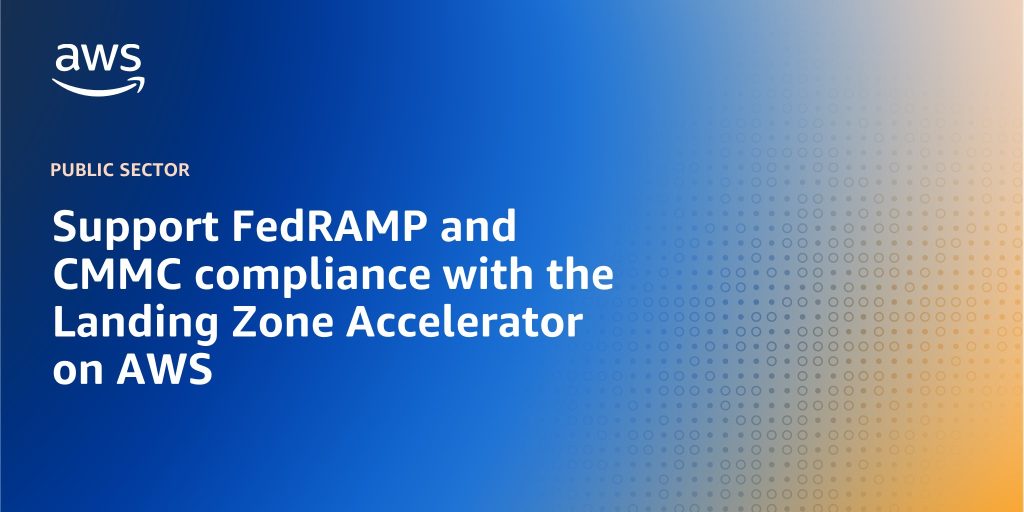AWS Public Sector Blog
Category: Technical How-to
Support FedRAMP and CMMC compliance with the Landing Zone Accelerator on AWS
Some US federal agencies and those who collaborate with them must support an automated, secure, and scalable multi-account cloud environment that meets Federal Risk and Authorization Management Program (FedRAMP) and Cybersecurity Maturity Model Certification (CMMC) standards. To support these needs, AWS customers and partners can deploy the Landing Zone Accelerator (LZA) on AWS. Recently, AWS worked with Coalfire, a FedRAMP-approved third-party assessment organization (3PAO) and AWS Partner, to assess and verify the LZA solution.
How to detect wildfire smoke using Amazon Rekognition
Since wildfires can double in size and intensity every three to five minutes, early detection and reduced response times are essential. Cloud technologies, including artificial intelligence (AI) and machine learning (ML), can help with this. Learn a high-level architecture to create a solution with AWS that uses AI to identify and classify wildfire smoke imagery and then rapidly alert and inform first responders about the location and condition of a fire incident.
Implement a secure, serverless GraphQL architecture in AWS GovCloud (US) to optimize API flexibility and efficiency
GraphQL is a query language and server-side runtime system for application programming interfaces (APIs) that prioritizes giving clients exactly the information they request and no more. GraphQL can help public sector customers focus on their data and provide ways to explore the data in their APIs. Learn a reference architecture using serverless technologies that you can use to build GraphQL-enabled solutions in the AWS GovCloud (US) Regions to unify data access in real-time and simplify operations.
Creating agentless outbound campaigns to support Medicaid unwinding efforts
With state Medicaid agencies (SMAs) contacting all their members, contact centers must scale to meet increased demand—however, staffing shortages can make this outreach and call support difficult. SMAs can support staff members and make sure members get their communications needs met by using AWS and cloud technology to introduce automation into their outreach process. Learn how to deploy a serverless outbound campaign to meet Medicaid unwinding outreach needs and support agency staff members by streamlining the outreach process.
Scaling intelligent document processing workflows with AWS AI services
As the daily volumes of document submissions increases for government organizations, intelligent document processing (IDP) solution architectures must absorb spikes in requests without creating delays or other impact for the users. In cases where the processing volume exceeds the limits of the resources available in an AWS Region, organizations can distribute the workloads across multiple regions to increase the document processing throughput. This post presents high-level architecture guidance built around Amazon Comprehend to create a distributed document processing workload that can overcome the challenges of unpredictable request patterns.
Extracting, analyzing, and interpreting information from Medicaid forms with AWS
What if paper forms could be processed at the same speed as digital forms? What if their contents could be automatically entered in the same database as the digital forms? Medicaid agencies could analyze data in near real time and drive actionable insights on a single dashboard. By using artificial intelligence (AI) and machine learning (ML) services from AWS, Medicaid agencies can create this streamlined solution. In this walkthrough, learn how to extract, analyze, and interpret relevant information from paper-based Medicaid claims forms.
How to store historical geospatial data in AWS for quick retrieval
Learn how to store historical geospatial data, such as weather data, on AWS using Amazon DynamoDB. This approach allows for virtually unlimited amounts of data storage combined with query performance fast enough to support an interactive UI. This approach can also filter by date or by location, and enables time- and cost- efficient querying.
Navigating common use cases spanning AWS GovCloud (US) and standard AWS
There may be use cases where customers must orchestrate actions spanning AWS GovCloud (US) and standard AWS partitions. The common reasons customers may need to invoke AWS services in a standard account from an AWS GovCloud (US) account (or vice versa) include: cross-domain applications, feature parity, and if the AWS service doesn’t exist in AWS GovCloud (US). In this blog post, learn how to navigate these scenarios.
Using Amazon IVS for turnkey town halls
Many nonprofit organizations need to provide their donors, members, and beneficiaries with relevant information that they can access from anywhere. Over the past few years, nonprofit organizations have seen positive results by hosting live town hall events in which members can receive important information and ask questions. In this walkthrough, learn how to set up Amazon IVS to build a turnkey live-streaming platform that integrates into an existing website.
Optimizing your nonprofit mission impact with AWS Glue and Amazon Redshift ML
Nonprofit organizations focus on a specific mission to impact their members, communities, and the world. In the nonprofit space, where resources are limited, it’s important to optimize the impact of your efforts. Learn how you can apply machine learning with Amazon Redshift ML on public datasets to support data-driven decisions optimizing your impact. This walkthrough focuses on the use case for how to use open data to support food security programming, but this solution can be applied to many other initiatives in the nonprofit space.









